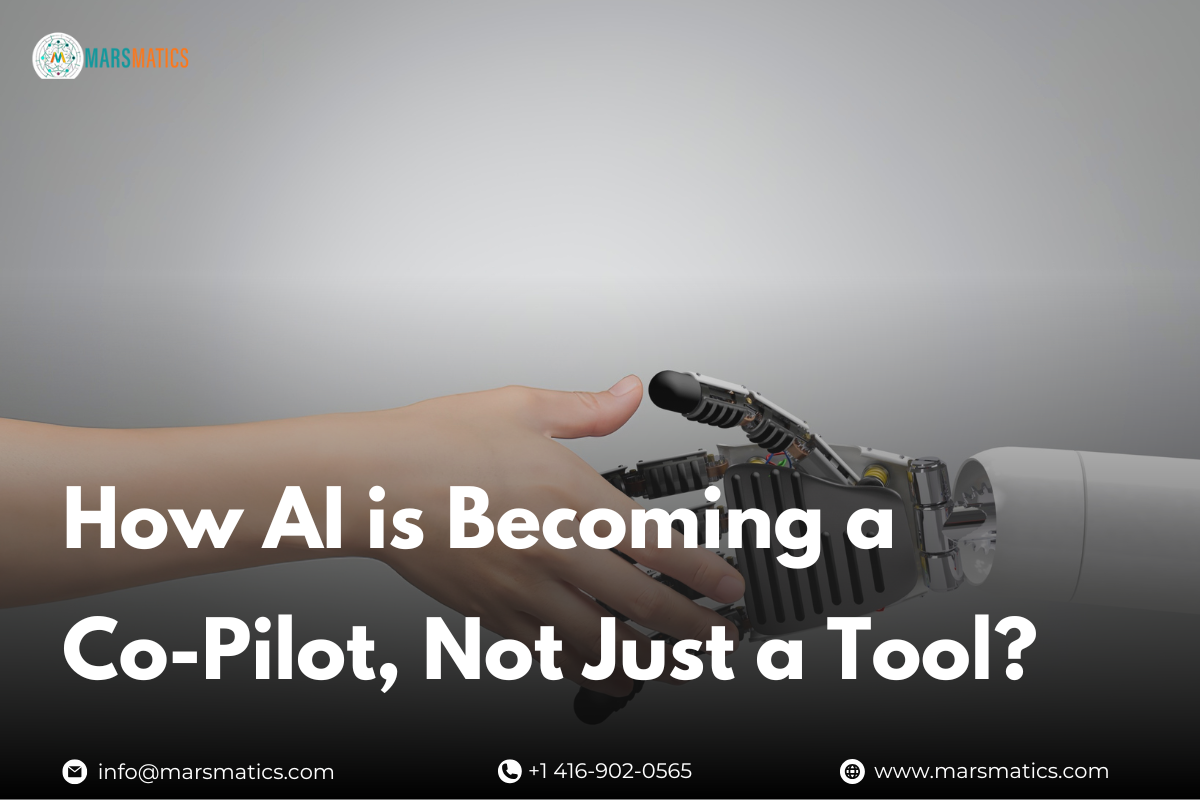How AI is Becoming a Co-Pilot, Not Just a Tool?
For decades, software developers have leaned on tools to speed up their workflows—from simple syntax checkers to full-blown IDEs. But 2025 marks a major leap forward. Today, AI is becoming a co-pilot, not just a tool, fundamentally changing how code is written, tested, and optimized. Instead of just aiding from the sidelines, AI is now sitting in the virtual cockpit with developers, making real-time decisions, fixing bugs, and even writing entire blocks of code. This new era of collaboration is more than automation—it’s augmentation.
The Evolution of AI in Software Development:
AI in software development has come a long way. In the early days, it was mostly used for tasks like auto-completion, spell-checking, or static analysis. These tools were reactive, waiting for the developer to make a move. But that’s no longer the case. Today, AI is a co-pilot—actively participating in the coding process and offering solutions even before developers ask. The journey from helper to partner has been driven by huge strides in natural language processing, machine learning, and contextual understanding.
What was once a futuristic idea is now real: AI co-pilot for developers is standard in many coding environments. It doesn’t just speed things up—it makes development smarter, more accurate, and incredibly efficient.
Also Read: AI in the Developer’s Seat: How Coding Tools Are Redefining the Modern Software Workforce
From Helper to Collaborator:
Earlier AI tools were like sidekicks—waiting for input, offering suggestions only when prompted. Now, they anticipate developer needs, understand coding context, and even guide architecture decisions. With tools like GitHub Copilot and Amazon CodeWhisperer, we’re witnessing what is Copilot truly means: an AI that not only supports but actively contributes to development.
The shift is clear: AI coding assistant technologies can understand the structure, logic, and intention of the code. They’re trained on billions of lines of code and respond in real-time—rewriting functions, spotting vulnerabilities, and offering performance improvements.
Key Technologies Leading the Shift:
So, what’s fueling this transformation? Platforms like GitHub Copilot, ChatGPT, and CodeWhisperer are setting the bar. These are not just intelligent auto-complete tools. They understand language prompts, predict developer intent, and generate meaningful code across multiple languages.
Examples of AI copilots also include Replit Ghostwriter and Tabnine, both of which offer collaborative coding environments where the AI does more than suggest—it leads. These systems are trained using massive open-source data, giving them the ability to mimic coding best practices across industries and languages.
Also Read: Tips for Developers to Adapt to AI Tools
Real-World Examples of AI as a Coding Co-Pilot:
Accelerating Code Writing:
One of the biggest advantages of having AI as a co-pilot is speed. Developers no longer need to write every function from scratch. With tools like Copilot, you can describe what you want in plain English, and the AI will write the code for you. This rapid prototyping has transformed workflows, especially for startups and teams under tight deadlines.
What is Copilot if not a time-saver? It enables devs to write clean, functional code in a fraction of the time, allowing them to focus more on problem-solving and less on syntax.
Reducing Bugs and Enhancing Security:
Bugs are inevitable in any coding project—but AI is helping reduce them significantly. Today’s AI co-pilot for developers doesn’t just help write code; it actively scans for errors and vulnerabilities as the code is being written. Some platforms offer instant security alerts and suggestions, reducing the time needed for QA and testing phases.
This proactive debugging is crucial for reducing technical debt and avoiding expensive mistakes. AI in software development now plays a critical role in improving both the performance and security of applications.
Smart Documentation and Refactoring:
Writing documentation is often seen as a chore, but AI is easing that burden. With a good AI coding assistant, you can generate summaries, inline comments, and even full documentation based on code context. This makes onboarding new team members easier and ensures consistency across the board.
Refactoring, once time-consuming and error-prone, is now streamlined. AI tools can identify redundant code, suggest modular designs, and improve readability—all without changing functionality. This reinforces the idea that AI is becoming a co-pilot, not just a tool, helping developers create maintainable codebases.
Also Read: The Pros and Cons of AIaaS
Benefits of AI as a Development Partner:
The shift from tool to partner means developers now have a true collaborator. AI as a co-pilot offers several key benefits:
- Increased productivity: Less time writing boilerplate code means more time for solving real problems.
- Better code quality: AI suggestions often follow best practices, reducing bugs and improving structure.
- Skill building: Junior developers learn faster by watching AI suggestions and patterns.
- Faster delivery: Projects move faster from idea to deployment with AI support.
When used wisely, AI co-pilot for developers transforms the development cycle into a smoother, smarter process.
Is AI Replacing Developers? Let’s Set the Record Straight
This is the million-dollar question. The short answer: No, AI is not replacing developers—it’s enhancing them. While AI can generate and improve code, it lacks human intuition, creativity, and problem-solving in complex or ambiguous scenarios.
Think of what is Copilot in this context: it’s a powerful assistant, but one that still requires a human at the helm. Developers remain essential for defining logic, understanding user needs, making design decisions, and ensuring ethical and responsible use of code.
Preparing for the AI-Powered Future:
Skills Developers Need to Thrive
To make the most of this shift, developers need to evolve. Skills in prompt engineering, reviewing AI-generated code, and understanding how machine learning models work will become invaluable. A growth mindset and the ability to adapt to evolving tools will set developers apart. Understanding AI in software development is no longer optional—it’s a necessary part of being an efficient, future-ready engineer.
Best Practices When Using AI Tools:
Just because AI can write code doesn’t mean you should accept it blindly. Review every output, test thoroughly, and treat AI as a second brain—not a replacement for your own.
Some tips:
- Always check logic and context
- Maintain documentation for human understanding
- Train your team on ethical and secure use of AI tools
By combining human judgment with AI efficiency, AI is becoming a co-pilot, not just a tool, and the best results come from the two working together.
Conclusion:
The era of using AI as a passive tool is over. In 2025, AI is becoming a co-pilot, not just a tool, transforming how we write, optimize, and deploy software. It’s not here to replace us—it’s here to collaborate with us. From faster coding and improved testing to real-time documentation and smarter refactoring, AI co-pilot for developers is unlocking new levels of productivity. The future belongs to those who embrace this synergy—and use it to build better, faster, and smarter software.
❓ FAQs
What is AI as a co-pilot in software development?
It refers to AI tools that work alongside developers—offering suggestions, writing code, detecting bugs, and streamlining workflows in real-time.
Is AI replacing human programmers in 2025?
No. AI enhances productivity but still lacks human creativity, logic, and decision-making skills essential to software development.
Which AI tools are best for coding assistance today?
Popular tools include GitHub Copilot, ChatGPT, Amazon CodeWhisperer, Tabnine, and Replit Ghostwriter.
How can junior developers benefit from AI co-pilots?
They can learn best practices by observing AI suggestions, accelerate their learning curve, and avoid common coding mistakes early in their careers.








